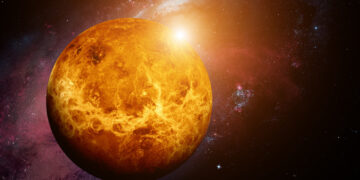Every 19 months, an astronomical event unfolds as Venus moves directly between Earth and the Sun, a moment known as an inferior conjunction. This weekend, Venus will once again pass between our planet and the Sun, an event that, while scientifically fascinating, remains largely invisible to the naked eye. Unlike solar eclipses or planetary alignments that dazzle skywatchers, Venus’s inferior conjunction is mostly lost in the Sun’s overwhelming glare.
What is an Inferior Conjunction?
Venus’s orbit around the Sun is closer than Earth’s, making it an inner planet alongside Mercury. As it moves along its orbital path, it periodically aligns with Earth and the Sun. When Venus appears on the opposite side of the Sun, it is at superior conjunction. When it moves between Earth and the Sun, it is at inferior conjunction.
During an inferior conjunction, Venus transitions from being an evening star—visible after sunset—to a morning star, appearing before sunrise. This transition marks a significant shift in Venus’s position in the sky, making it momentarily unobservable before it re-emerges on the other side of the Sun.
Why Can’t We See It?
Despite being the third brightest object in the sky after the Sun and Moon, Venus becomes virtually impossible to see during an inferior conjunction. The reason is simple: the overwhelming brightness of the Sun obscures Venus entirely. Unlike a solar eclipse, where the Moon temporarily blocks the Sun’s light, Venus is too small and too far away to be visible against the intense solar backdrop.
Astronomers using specialized solar telescopes with advanced filtering techniques can track Venus’s position. However, for casual skywatchers, the planet disappears into the Sun’s glare and only becomes visible again as it moves into the morning sky in the days following conjunction.
The Phases of Venus and How They Change
Much like the Moon, Venus goes through phases as seen from Earth. These phases change depending on its position relative to the Sun. Before and after inferior conjunction, Venus appears as a slender crescent when viewed through a telescope. This happens because only a thin portion of its cloud-covered surface is illuminated by the Sun from our perspective.
At its greatest elongation, when Venus is at its farthest apparent distance from the Sun in our sky, it appears as a bright half-lit disk. As it approaches conjunction, its crescent thins and grows larger due to its proximity to Earth. However, this is best seen through telescopes since Venus’s brightness often outshines its finer details to the unaided eye.
Venus’s Orbit and How It Differs from Earth’s
Venus orbits the Sun at an average distance of about 67 million miles (108 million kilometers), completing one orbit every 225 Earth days. However, because Earth also moves in its orbit, it takes Venus approximately 584 days to return to the same position relative to Earth and the Sun. This is why inferior conjunctions occur roughly every 19 months.
Unlike most planets in the Solar System, Venus has an unusual retrograde rotation, meaning it spins in the opposite direction of its orbit. This means that if you stood on Venus, you would see the Sun rise in the west and set in the east. Moreover, a day on Venus (243 Earth days) is longer than its year (225 Earth days)!
How to Observe Venus Before and After Conjunction
Even though Venus is hidden during conjunction, it remains observable in the days leading up to and following the event.
- Before Conjunction: Venus appears in the evening sky near the horizon just after sunset. It is one of the brightest objects in the sky and sets shortly after the Sun.
- After Conjunction: Venus moves to the morning sky, rising before sunrise and appearing higher each day as it moves away from the Sun’s glare.
Using a telescope, skywatchers can track Venus’s phase changes, watching as its crescent shape grows thinner and then thickens again after conjunction. However, extreme caution must be taken—never attempt to observe Venus near the Sun without proper solar filters to protect your eyes and equipment.
Venus in Popular Culture and Future Explorations
Venus has long captured human imagination. The inferior conjunction has inspired literature, music, and art, including Paul McCartney’s song “The Kiss of Venus”, which references this celestial event.
In the coming years, Venus will take center stage in space exploration. NASA and the European Space Agency (ESA) have planned several missions:
- NASA’s DAVINCI Mission (2029): This mission will drop a probe into Venus’s atmosphere, collecting data on its composition and weather patterns.
- NASA’s VERITAS Mission (2031): A spacecraft will map Venus’s surface using radar to study its geological history.
- ESA’s EnVision (2030s): This European mission will investigate Venus’s atmosphere and surface interactions, searching for signs of past habitability.
Conclusion: A Hidden but Significant Event
Though Venus’s inferior conjunction is not a spectacular sight for the naked eye, it marks an important astronomical milestone. It reminds us of the intricate dance of planets, the power of celestial mechanics, and the rich scientific opportunities our neighboring worlds offer.



















